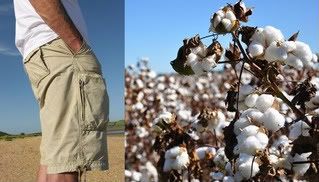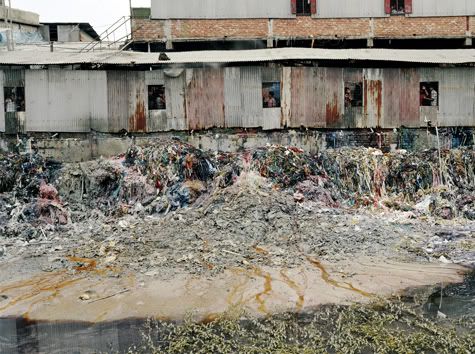We have so many clothes yet we feel we "need" a new pair of jeans, shoes, shirt, etc. we all have enough clothes in our closet to last a lifetime yet we still go shopping regularly.
at what price?
the clothes you buy may be super cheap if you're getting them from places like forever21 or h&m but there's a greater hidden cost to clothes that are mass produced. Waste, use of toxic chemicals (formaldehyde, pesticides, etc.), oil and water consumption, pollution, water contamination, and sweatshops are just a few of the negative impacts.
here's a little about today's "fast fashion" from http://www.eco-asia.info/content/f-fashions-dark-side
"'Fast Fashion' encourages consumers to purchase un-needed clothes on an increasingly rapid cycle. Local and International media, fuel the demand, helping to create the desire for new 'must haves' for each season, targeting young women across the globe. The concept of 'Fast fashion' caused a media phenomenon five years ago, when it first gained a high profile following fashion icon Karl Lagerfeld’s collaboration with the international Swedish fashion brand H&M.
Nowadays, most high street fashion labels will have something new every month, instead of just two collections (Autumn/Winter and Spring/Summer) each year. It gives shoppers the latest styles just six weeks after they first appear on the catwalk, at prices that mean consumers can wear an outfit once or twice and then replace it. What’s wrong with this, you may ask?
Nothing, if you don’t care whether the labours are being treated fairly behind the label. Nothing, if you think it’s perfectly fine with our current consumption way of 'fast fashion'. Nothing, if you don’t care whether the environment has had enough of our waste couture.
Environmental damage
The environmental impact of the textile industry arises in particular from its use of energy and toxic chemicals. The sector contributes to climate change through its need to burn fossil fuels to create electricity to heat water and air in the laundering process. Other major energy uses arise in providing fuel for agricultural machinery and electricity for production. Toxic chemicals are used widely in cotton growing and in many manufacturing stages such as pre-treatment, dyeing and printing. Waste volumes from the sector are high and growing with the advent of ‘fast fashion’, according to a report from researchers at Cambridge University titled “Well Dressed?”.
It is undeniable as regard to the current situation that the "Fast fashion" is causing a pollution footprint, with each step of the clothing life cycle generating potential environmental and occupational hazards.
Fabrics that Matter
Food will always be the first thing that comes to our mind when we think about living a healthier lifestyle, not clothing. But we must be aware of the potential health hazard of fabrics, treated with chemicals during and after processing. These chemicals not only leach into the environment, leaving an impact on groundwater, wildlife, air and soil, but they can also be absorbed or inhaled directly.

Most clothing labeled “non-iron” contains PFCs and each year conventional cotton producers around the world use nearly US$2.6 billion worth of pesticides.
The hot and humid climate of Southeast Asia make cotton fabrics such as khaki twill and denim almost a necessity for surviving the heat. Once worn only by military personnel, fabrics such as brushed cotton twills, ripstop, bedford cord, lustre cotton, polyester and wrinkle-resistant synthetic fibres have taken khaki into the mainstream. Unfortunately perfluorinated chemicals (PFCs), which include the non-stick additive Teflon, are increasingly being added to garments because it makes them last longer and also can make them wrinkle-free. Meanwhile, fabrication of petroleum-based fabrics like nylon and polyester is energy-intensive and greenhouse-gas producing.
The unpalatable truth, according to the US Environmental Protection Agency (EPA), is that PFCs are cancer-causing compounds. Dr Richard Dixon, Head of the World Wildlife Federation (WWF) Scotland adds, “The use of man made chemicals is increasing, and at the same time we have warning signals that a variety of troubling threats to wildlife and human health are becoming more prevalent”. Most clothing labeled “non-iron” contains PFCs, don’t say you have not been warned!
Cotton is not so innocent either, there are various environmental considerations to be taken into account, such as the heavy use of pesticides, dyes and other chemicals in the finishing process, which cause pollution. Based on figures from the Pesticide Action Network North America, each year conventional cotton producers around the world use nearly US$2.6 billion worth of pesticides - more than 10% of the world's pesticides and nearly 25% of the world's insecticides.
Social Impacts on Developing Countries
Brands are successful because people prefer them to generic products. As a consumer, we may ask ourselves what makes a good brand? Its product or service promise? Its market share? Its all singing, all dancing logo? However, an increasingly important aspect is a brand’s efforts in the sphere of Corporate Social responsibility - isn’t it the corporate should always taking account on the responsibility for the impact of their activities on the environment, consumers, employees, communities, stakeholders and all other members of the public sphere?
The garment industry has the potential to empower workers, build economies, and lift millions of people out of poverty.
Last year, ‘Let’s Clean Up Fashion’ (an organisation concerned with the negative effects of the fashion industry) carried out its annual survey, Martin Hearson, the report’s author, said, “The fashion industry is split between companies that recognise the problem of poverty wages and are taking action to fix it, and those that aren't. As that gap widens, the do-nothing brands like French Connection, River Island, Matalan and Peacocks are going to be left further and further behind." As costs have risen over the years, factories have moved to low-wage, developing countries. In the 1970s it was Hong Kong, Taiwan and South Korea. Today it’s China, Bangladesh and Indonesia, among others.
How would you feel when multi-billion dollar corporations who control nearly 60 percent of the market run the global market for luxury items, turn a blind eye in the name of ever bigger profits and disregard the welfare and working condition of their worker?
In December 2007, an Italian national TV channel broadcast a documentary, "Slaves of Luxury," (Schiavi del Lusso) that linked several luxury brands in Italy to low-paid and often illegal Chinese labour. Workers earn between 90 euro cents to €1.50 if they work all night in cramped workshops. Prada and Ferragamo were quoted in the documentary as stopping such subcontract work when alerted to the issue.
Ironically, the garment industry has the potential to empower workers, build economies, and lift millions of people out of poverty but it seems to have forgotten its obligations in regard to Corporate Social Responsibility. As consumers, we need to be somewhat wiser and smarter, and should take the initiative to always reconsider what we are buying into. Knowing that the fashion industry can incorporate ethical practices at all levels, perhaps we should make use of our spending power to gain a voice, it’s the most prevailing of all."
Here's a great article on the process of manufacturing:
http://www.make-do-and-mend.org/overconsumption_of_clothes__2.html

Textile Factory in Bangladesh. Wastes from the factory spill into a stagnant pond.
Think about it next time you feel like you "need" a new article of clothing. Does the world really need to suffer so that you can wear the latest fashions and then throw it away after a few times?
If you want to make a difference here's a few tips:
-Buy your clothing from thrift stores, vintage stores, recycled fashion stores, or flea markets. We already have so many clothes in circulation right now. Re-using what we already have is more eco-friendly than buying new eco-friendly products. The less we buy new equals less supplied which equals a better, greener future.
-If you make your own clothes, re-use fabrics instead of buying new fabric from fabric stores.
-Donate your old clothes to thrift stores or to someone in need or sell them on ebay or trade them at places like the buffalo exchange and crossroads. Don't throw anything away!
-If you absolutely have to buy something new look for eco-friendly, organic, naturally died, fair trade products.
-Re-post the article above. Share it with everyone! Some people really just have no idea what goes into making their clothes. Spread awareness!
-Don't support "fast fashion" or big time corporations. They don't care what they do to the environment or other people as long as they're making a profit.





very, very, very good post! thanks for sharing!
ReplyDelete